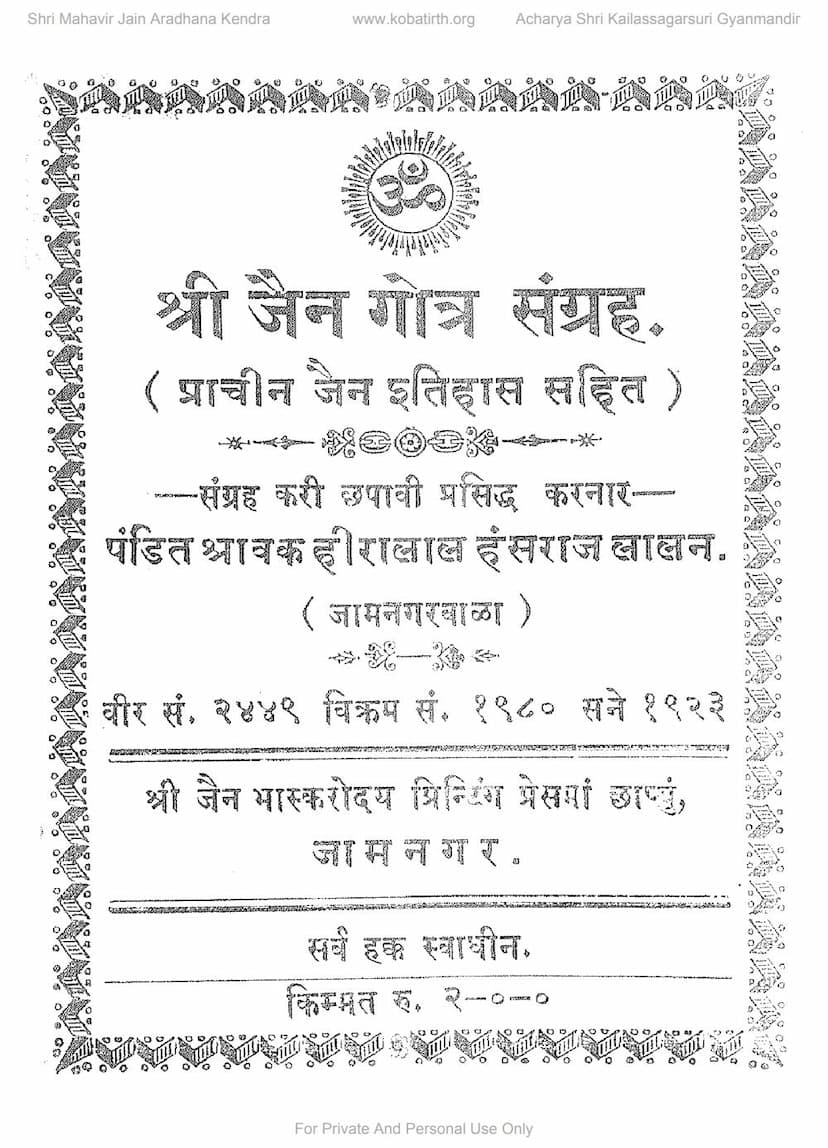Jain Gotra Sangraha
Added to library: September 2, 2025

Summary
Here's a comprehensive summary of the Jain text "Jain Gotra Sangraha" by Shravak Hiralal Hansraj, based on the provided pages:
Book Title: Jain Gotra Sangraha (Jain Gotra Collection) Author: Shravak Hiralal Hansraj (from Jamnagar) Publisher: Shravak Hiralal Hansraj Publication Year: Veer Samvat 2449 / Vikram Samvat 1980 / 1923 AD Published at: Shri Jain Bhaskarodaya Printing Press, Jamnagar
Overall Purpose and Content:
"Jain Gotra Sangraha" is a historical compilation aimed at preserving and disseminating ancient Jain genealogical and historical information. The book focuses on the origins, history, and lineage of various Jain communities, particularly highlighting their gotras (lineages or clans). The author, Hiralal Hansraj, emphasizes his effort in collecting and publishing this information from ancient handwritten manuscripts, which were often in a disorganized state and not widely circulated due to the fear of losing livelihood by those who possessed them. The book aims to provide valuable historical insights to the Jain community.
Key Themes and Sections:
The book is structured with a detailed index covering a wide range of historical and genealogical topics. Some of the prominent themes and sections include:
- Establishment of the Eighty-Four Gacchas (Sects/Orders): The book details the historical establishment of 84 Gacchas, attributing this to Acharya Udyotansuri. It lists the names of 84 disciples to whom Acharya Udyotansuri bestowed the title of 'Suri', which led to the formation of various Gacchas, with their names often derived from the villages where their first Chaturmas (four-month rainy season stay) took place. The "Vatgaccha" is mentioned as originating from the installation of Suris under a large banyan tree.
- History of Bhinmal (Shrimal): A significant portion of the book is dedicated to the history of the ancient city of Bhinmal (also known as Shrimal, Ratnamal, Pushpmal, and Mitramal in different eras). It recounts the city's history, including invasions, royal successions, and the origins of various communities within it.
- Origins of Jain Communities: The book traces the lineage and conversion of several communities to Jainism. Notably, it details the conversion of:
- Shrimali Jains: The book explains the origin of the Shrimali community and lists their 62 Gotras, along with the names of prominent merchants associated with each Gotra.
- Porwad (Pragvat) Jains: It describes the conversion of eight merchants from the Magwat Brahmin community to Jainism, who then became known as Porwad Jains.
- Oswal Jains: The book outlines the origin of the Oswal community from Kshatriyas in the city of Osha, approximately 52 years after Lord Mahavir and 675 years after Lord Parshvanath. It attributes their conversion to Acharya Ratnaprabhasuri.
- Gotras and Sub-Gotras: A core focus of the book is the listing and explanation of various Jain Gotras. The text extensively details the origins of numerous Gotras (e.g., Hariyana, Gaha, Nagada, Laghu Nagada, Mithadiya, Vadhora, Hathudiya Rathod, Padaiya, Vahani, Jasala, Bohad, Kamasa, Chauhan, Katariya, Katyayan, Sandasa, Bhadrayan, Agneya, Kashyap, Vardh, Parayan, Vansiyan, Khodayan, Lodhayan, Paras, Lachhil, Chandisar, Vishapahar, Gandhi, Devandasakha, Gautam, Loladiya, Dehil, Mahalakshmi, Papach, Pushpayan, Karis, Kantia, Dedhiya, Boricha, Syal, Mahajani, Mehudiya, Songira). For each Gotra, it often provides:
- Its origin story, frequently linking it to a specific Acharya, a king, a merchant, or a divine event.
- The community it belongs to (e.g., Shrimali, Oswal, Porwad).
- Main and sub-branches or distinctive practices (odak).
- Information about their Gotradevi (clan goddess) and associated rituals.
- Geographical locations where the descendants settled.
- History of Gacchas and Acharyas: The book provides details about the lineage of various Gacchas, such as the Naanag, Vallabhi, Vidhipaksh, and Anchalgaccha, listing the names of their Acharyas and the approximate years of their Acharya-hood.
- Role of Kulagurus: The text elaborates on the historical importance and defined roles of Kulagurus (family preceptors) within the Jain community, including their rights and responsibilities in matters like initiating disciples, performing rituals, and maintaining historical records.
- Royal Patronage of Jainism: The book highlights instances of royal families and rulers embracing Jainism and patronizing the faith, contributing to its spread and influence.
- Community Practices and Traditions: It touches upon various rituals, customs, and traditions associated with different Gotras and communities, such as specific offerings to their Gotradevis, marriage customs, and community gatherings.
Author's Contribution:
Shravak Hiralal Hansraj presents his work as a labor of love and dedication. He expresses his hope that the collection of this ancient, often fragmented, historical and genealogical data will be beneficial to the Jain community. He diligently gathered information from old manuscripts to compile this comprehensive work. The book also includes a note about further information being available in family genealogies (ambo or vanshavali) for specific Gotras, which could be procured for a fee.
Historical Context:
The text reflects a period when oral traditions and handwritten records were the primary means of preserving history. The author's efforts highlight a concern for preserving this heritage from being lost to time or limited accessibility. The dates and events mentioned provide a glimpse into the historical timeline of Jainism and the migration and settlement patterns of its followers.
In essence, "Jain Gotra Sangraha" serves as a vital genealogical and historical reference for the Jain community, offering insights into their past, the origins of their various sub-communities and their Gotras, and the historical events that shaped their religious and social landscape.